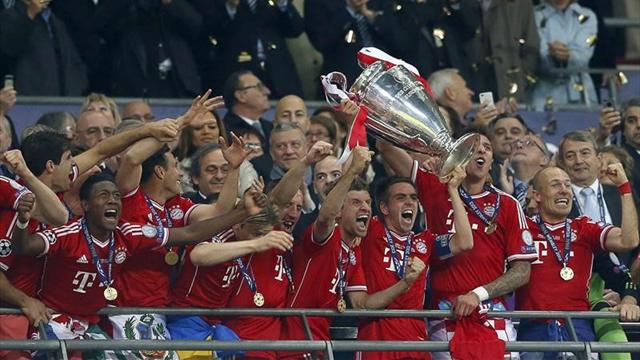The tactical battle between Jupp Heynckes and Juergen Klopp in the Champions League final on Saturday made for a captivating football game that bypassed the usually edginess and uncertainty that shrouds most high-profile finals. Heynckes prevailed and his experience in European football proved that he had the tactical capability to demolish the yellow wall that had built itself inside Wembley.
Bayern Munich were offensively impressive in their movement amongst Arjen Robben, Thomas Mueller and Franck Ribery. The two wingers are reputable for hogging their side of the touchline and making the pitch as wide as possible. But at Wembley on Saturday the interchange between the front-line behind Mario Mandzukic pulled the Dortmund defence across the pitch, widening gaps for the striker to exploit himself. By interchanging the dynamic threesome, the defensive qualities of Ilkay Gundogan were diminished and Dortmund pushed a higher line to track them; consequently creating space in behind. The passes in the attacking third from the Bayern trio display just how much influence they had right across the pitch, operating in all areas of the final third.
The first goal came from Ribery’s pass into space behind the Dortmund defence that was exploited by a roaming Arjen Robben. He slipped it to Mandzukic who slotted it home for the opener. The movement was even more evident in the winning goal where Ribery pulled Lukasz Piszczek to a central position, Mueller occupied Neven Subotic to the left and an onrushing Robben exploited the gap between them to secure the trophy for Munich.
It was apparent in the first 20 minutes that Dortmund had adapted a high pressing game to prevent Bastian Schweinsteiger from influencing the game between defence and attack. This meant, whether it was pre-match tactics or adaptation, Bayern exploited the long ball to the forwards. Jerome Boateng and Dante consistently overlooked the midfield to directly hit the Bayern front-line, which also prevented Sven Bender and Ilkay Gundogan from intercepting the play and launching an attack of their own; Bender made just three interceptions while Gundogan was restricted to two.
Arjen Robben’s winner came from a direct long ball from defence, Boateng playing it to Ribery, but the second-half did develop into a shorter passing game from Bayern as Schweinsteiger’s dominance in midfield grew.
The German midfielder was restricted in the first-half due to Dortmund’s high intensity and struggled to play any sort of pass forward. But as Klopp’s men tired, Schweinsteiger was able to make his side tick and had a greater indirect influence on the final. He completed almost double the amount of passes of his Dortmund counterpart in Gundogan, with a total of 76 passes attempted and a completion rate of 86%. In the first half Schweinsteiger completed only four passes in the attacking third as the Borussians assaulted Manuel Neuer’s goal, but he more than doubled his influence in the opposition half after the break.
Both Ribery and Robben have developed a working relationship with full-backs David Alaba and Philipp Lahm that have surprised many. Not only have Bayern’s two wingers developed their game defensively, which was evident against Barcelona, but the offensive understanding between the two pairs have created greater intensity and combinations. Heynckes has succeeded where many have failed before and in the final Alaba and Lahm’s offensive width allowed Ribery and Robben to play inside and interchange with Mueller. The pass combination of Alaba to Ribery was the highest with 16 passes between the pair, whereas Lahm to Robben was only four passes less. Heynckes’ side were able to bypass the crowded midfield, especially in the first 45 minutes, and not allow Reus, Bender and Gundogan to put pressure on Schweinsteiger and Javi Martinez.
Robben received the ball from Lahm in the opposition half, perhaps exploiting Dortmund’s one weakness in Kevin Grosskreutz, whereas Alaba used his energy and stamina levels to operate with Ribery in all areas of the field.
Bayern Munich struggled in the opening stages of the match but were working towards putting Heynckes’ tactics to play. Dante and Boateng played a major role in hitting the front three of Ribery, Mueller and Robben and in the process were able to weaken the influence of Dortmund’s midfield. But the match was won by the adaptability of the Bayern front trio and it worked to create gaps and spaces between the usually organised defence of the yellow wall. The pace and positivity of Ribery and Robben worked beautifully with Mueller’s uncanny ability to find space when there isn’t any. In the end it was only a matter of time before it all combined to gift the trophy to the ‘nearly men.’









































